For more than a century, the semi-annual meetings of the American Astronomical Society (AAS) have continued to provide the primary platforms for American scientists to share the latest developments in astronomical research. Even in the depths of the COVID-19 pandemic, AAS meetings persisted by going online. Beginning with the June 2022 meeting in Pasadena, the AAS format switched to a hybrid arrangement of in-person and online participation. This same format continued with the January 2023 meeting in Seattle. Herein, I discuss a selection of “dispatches” from these two meetings, salting the descriptions with a few personal perspectives.
Women in Astronomy – The Struggle Continues:
The June 2022 meeting was the 240th meeting to be hosted by the AAS. Much has happened since the organization’s first meeting to include more women as part of the professional field of Astronomy (see Figure 1). Still, there remains so much to do to equalize the playing field for women as well as other underserved minorities (e.g. black and indigenous people of color [BIPOC]; lesbian, gay, bisexual, trans, queer, etc. [LGBTQ+]).
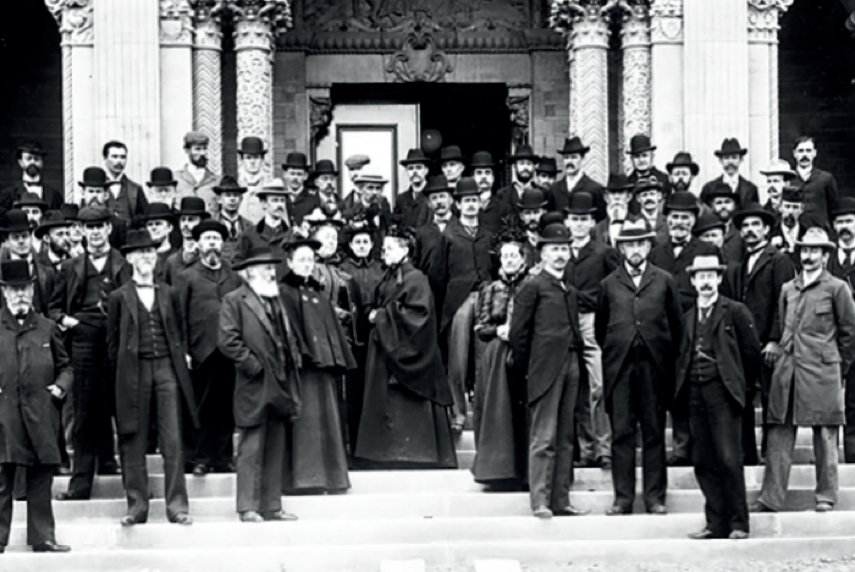
In her plenary talk, Jocelyn Bell Burnell (Oxford University) brought us up to speed with the evolving situation for women in Astronomy. Burnell is well-known as a pioneer of radio astronomy, and more regrettably, for not being co-awarded the Nobel Prize in Physics despite having co-discovered with Anthony Hewish the blinking sources of cosmic energy that are known today as pulsars. She has since received other honors and accolades, including most recently the Gold Medal from the Royal Astronomical Society (RAS).
Looking into the history of women membership in the International Astronomical Union (IAU), Burnell found that the participation has increased somewhat from 12.8% in 2005 to 18.3% in 2020. Women in leadership roles have increased significantly, but the overall female membership remains stubbornly stuck below the ~50% female representation in the global population. She also found that the percentages vary by country – with Argentina, France, and Italy being above average, but with India, Japan, the UK and USA being below average. The Netherlands appears to be moving up which prompted her to speculate on possible causes for these national variations. Perhaps in the favored countries men are seeking more prestigious jobs than in Astronomy, or women have parents nearby to mind their children, or their households have other kinds of support from low-paid workers.
Meanwhile, the situation with BIPOC representation among Americans in Astronomy remains embarrassingly below the ~40% figure for the overall population. These statistics continue to challenge the astronomical community to take on the hard work that is necessary to ensure justice, equity, diversity, and inclusion (JEDI) in the astronomical profession. To its credit, the AAS hosts several committees dedicated to enhancing the inclusion and treatment of underrepresented minorities (see https://aas.org/committees-and-working-groups).
Parsing the Cosmic Dust:
If you have ever viewed the night sky from a dark location that was free of moonlight and light pollution, most likely you would have perceived the gauzy Milky Way arching overhead (see Figure 2). A closer examination would reveal that the Milky Way is riddled with dark patches of obscuring dust. This phase of interstellar matter co-dwells with the more massive amounts of hydrogen gas that permeate the Milky Way. It is thought to consist of microscopic grains with sizes no larger than the particles that make up cigarette smoke. Born in the outer atmospheres of dying giant stars and in the nebular remnants of supernova blasts, the dust grains are made of silicon- and carbon-bearing compounds, often with a coating of various ices such as water, carbon dioxide, methane, and ammonia.
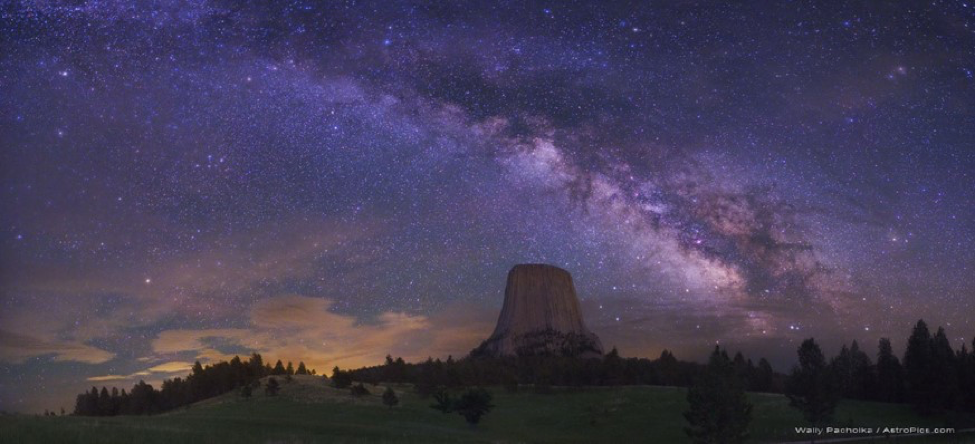
In her press conference presentation, Angela Speck (University of Texas, San Antonio) focused on the dust grains’ formation process. She noted that expiring and exploding stars produce mostly crystalline dust akin to diamond, whereas most of the interstellar medium contains amorphous dust with no regular crystal structure. In laboratory experiments, she has found that the process of crystallization involves the release of significant energy which heats the crystals to higher temperatures and so causes them to glow brighter. Therefore, our mid- and far-infrared images of dusty gas clouds are most likely biased towards the still-warm crystalline variety. We are left under-sampling what is really out there between the stars.
This overall picture of the dusty interstellar medium was bolstered by the following presentation by Jeonghee Rho (SETI Institute) who has observed supernova remnants in the far-infrared for several years. Using the HAWC+ instrument aboard the Stratospheric Observatory for Infrared Astronomy (SOFIA), Rho and her team have mapped the polarized emission from the warm dust in the Cassiopeia A supernova remnant. She found the polarization (P) to be remarkably strong, with co-aligned P-vectors throughout the nebula that confirm the presence of elongated (crystalline) dust grains in the presence of a coherent magnetic field (see Figure 3). She estimates the total mass of dust in the nebula to be about 1/5 that of the Sun – a hefty amount that could provide for much of the dust in galaxies. This violent sourcing of cosmic dust would be especially prevalent in the early universe, when the first massive stars were rapidly evolving and exploding.
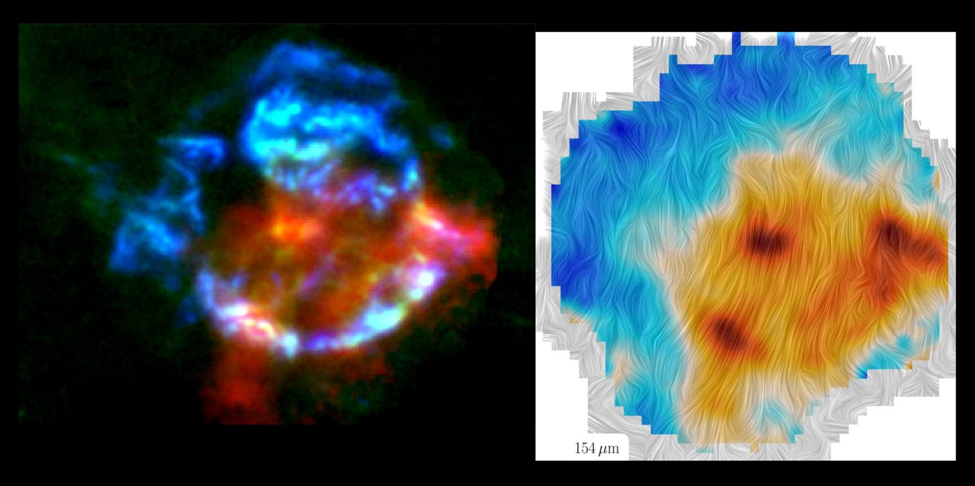
Tracing Galaxy Evolution to its Starbursting Youth:
For me, the highlight of the June meeting was the plenary talk by Nick Scoville (Caltech) who this year received the AAS Henry Norris Russell Prize for a lifetime of achievement in Astronomy. Prof. Scoville helped mentor me in the 1980s, when we were both at the University of Massachusetts, Amherst working together on a radio survey of giant molecular clouds in the Milky Way. My small contribution then as a fledgling grad student was to ascertain that massive stars form mostly inside the giant clouds rather than on their surfaces, as previously claimed. Since then, Scoville has been pursuing these star-forming systems at ever greater sensitivity and acuity out to high redshifts and correspondingly primordial lookback times.
Over the last twenty years, Scoville has led the Cosmic Evolution Survey (COSMOS), whose goal was to characterize the formation and evolution of galaxies along with their cosmic structuring. The survey spans a 2 square-degree field of view that has been imaged at multiple wavelengths spanning the electromagnetic spectrum. He and his team hit paydirt with observations at sub-millimeter and far-infrared wavelengths, as these observations respectively trace the amounts of star-forming gas and the resulting rates of massive star formation. The ALMA array of radio telescopes, observing at sub-millimeter wavelengths, provided well-resolved measures of the molecular gas masses in more than 700 galaxies contained within the COSMOS field of view. The galactic emission arises from glowing dust in the gas clouds. Nick and his colleagues found that the long-wavelength “tail” of the submm-wave emission scales proportionately with the amount of dust and – by extrapolation – with the mass of gas in these galaxies (see Figure 4).
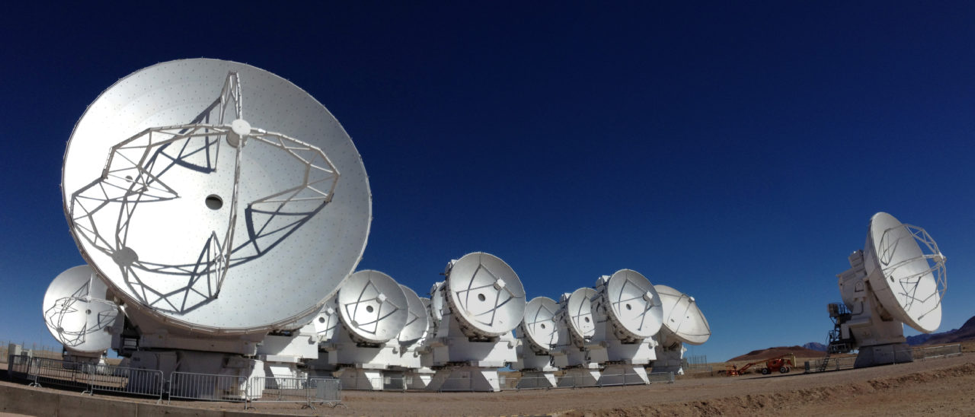
To gauge the rates of massive star formation, he and the COSMOS team used far-infrared observations from the European Herschel Space Observatory (see Figure 5). At these somewhat shorter wavelengths, the emission is dominated by glowing dust that has been warmed to higher temperatures by the newborn massive stars that are entrained within and among the clouds. The intensity of this emission directly scales with the number of short-lived massive stars, and by inference, the rate of massive star formation.

By tracking both the gas masses and starbirth rates in galaxies out to high redshift, Scoville and his colleagues found that the masses and rates greatly exceeded those found in galaxies of the local (current-epoch) Universe by factors of 10-100. Moreover, the starbirth rates per unit mass of gas – ie. the efficiencies – were significantly elevated. It appears that galaxies in the early Universe were truly ablaze with rampant starbirth activity, just as they were assembling from the morass of sub-galactic clumps some 12 billion years ago. Scoville attributes these tirades of massive star formation to collisions between molecular clouds during all that merging and melding. To find out how far back in time this transformational phase of galaxy evolution can be perceived, he and the COSMOS team anticipate that their targeted observing program with the James Webb Space Telescope (JWST) will provide new insights. Way to go, Nick!
JWST Aces Its Debut:
By far, the highlight of the January 2003 AAS meeting was the first science to emerge from the James Webb Space Telescope (JWST). This incredible gold-plated eye on the sky required a whole host of new technologies to work perfectly from the get go. Its humongous 6.5-meter diameter primary mirror had to be segmented into 18 hexagonal pieces which folded upon themselves in order to fit into the rocket faring. So too, the gossamer-thin five-layer sunshield made of aluminum- and silicon-coated film would span the area of a tennis court once fully deployed and hence had to be carefully pleated like a concertina for its ride atop the rocket. All this had to survive the launch and unfurl precisely while on its voyage towards L2 – the special point a million miles from Earth in the direction opposite the Sun, where the gravitational influences of the Earth and Sun combine for a stable parking mini-orbit around L2.
Development of the JWST design and necessary engineering began in the mid-1990s. I remember my time as a postdoctoral fellow at NASA’s Goddard Space Flight Center, when some of the civil servants and contractors there started work on the fledgling mission. Little did they know that it would take more than 25 years to get the novel telescope built, tested, and launched. I salute my former colleagues Jonathan Gardner, Randy Kimble, Alexander Kutyrev, John Mather, Susan Neff, Eric Smith, Bruce Woodgate, and so many more at NASA/GSFC – and beyond – who kept their eyes on the prize all those years (see Figure 6).
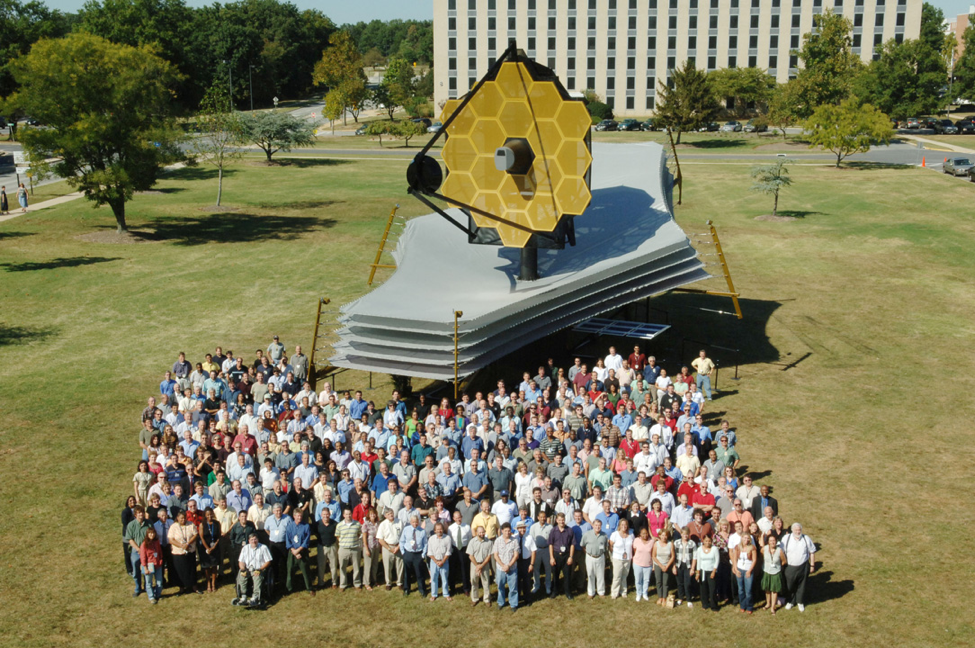
In her plenary talk, Jane Rigby (NASA/GSFC) described the excitement leading up to full deployment of the telescope. Everything had to work perfectly, or else they would have a complete dud drifting through interplanetary space. But they nailed the launch on Christmas Day 2021, the various unfolding and unfurling, parking at L2, and final adjustments of the mirror segments so that pinpoint stellar images were achieved on March 13, 2022. The parking maneuver hit right on the money, ensuring a mission lifetime up to twenty years. That means we should get a good return on our investment. Consider that the overall cost of the mission has been estimated at $10 billion. When spread over 148 million U.S. taxpayers and a 20-year lifetime, this expenditure should cost the individual taxpayer an average of about $3.40 per year. I would consider that outlay of funds quite the bargain.
As of the January 2023 meeting, JWST has …
- provided unique infrared views of Mars. Jupiter, Titan, and Neptune (see Figure 7).
- discovered its first Earth-size exoplanet via the transit technique (LHS 475 b).
- imaged the gas giant exoplanet HIP 65426 b at multiple infrared wavelengths.
- obtained transmission spectra of the atmospheres blanketing several exoplanets (including the “hot Saturn” gas giant WASP-39 b and the “puffy” gas giant” WASP-96 b) that show signatures of carbon dioxide, water, and – for WASP-39 b – sulfur dioxide, sodium, and potassium.
- imaged in stunning detail a debris disk around the young red dwarf star AU Microscopii.
- resolved 17 concentric rings of dust emanating from the hot Wolf-Rayet binary star system WR 140. These dusty expulsions represent more than a century of that star’s history, as it episodically infused the interstellar medium with chemically-enriched material.
- revealed detailed structures and previously hidden protostars in sundry star-forming nebulae, including the Carina Nebula and Eagle Nebula in the Milky Way, Tarantula Nebula in the Large Magellanic Cloud, and NGC 346 in the Small Magellanic Cloud.
- added previously missing views of glowing gas and dust associated with nearby star-forming galaxies, including the Phantom Galaxy, NGC 1566, NGC 7496, the Cartwheel Galaxy, and Stephan’s Quintet. The exquisite web-like patterns in these views defy simple dynamical explanations.
- detected remote primordial galaxies out to redshifts of z = 11-20 that correspond to lookback times exceeding 13.5 billion years. These detections push back the era of galaxy formation to only 200-400 million years after the Hot Big Bang. How these galaxies got themselves together so soon after the Big Bang remains a mystery.

Requiem for SOFIA:
NASA’s decades-long commitment to actualizing JWST – despite the mission’s many delays and cost overruns – meant that something else in the agency’s space science portfolio had to give. That appears to be the case with its termination of the Stratospheric Observatory for Infrared Astronomy (SOFIA). This high-flying 747 jumbo jet outfitted with a 2.7-meter infrared telescope was a joint venture between NASA and the German space agency DLR. It began “routine” scientific operations in 2011 with an anticipated operational lifetime of 20 years. One key advantage of this airborne facility was its easy accessibility – for repairs, development and deployment of new instrumentation, and for research experiences involving educator “ambassadors.” But the flights at $85M/year were deemed too expensive relative to the scientific output, and so the National Academies’ Decadal Survey of Astronomy and Astrophysics recommended in November 2021 that the observatory be mothballed early. The aircraft took its last scientific flight in September 2022 and is now at the Pima Air and Space Museum near Tucson, Arizona in preparation for display.
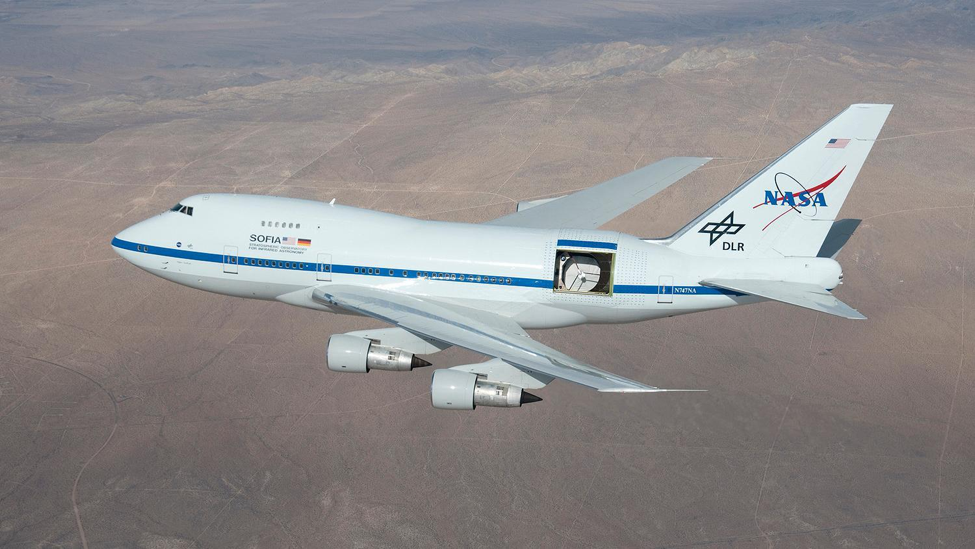
Meanwhile, science from SOFIA continues to roll on. At the January 2023 AAS meeting, there were no fewer than two press conferences and 32 presentations based on SOFIA science. Much of the research relied on SOFIA’s unique spectroscopic and polarimetric capabilities at far-infrared wavelengths. The spectroscopic mapping of water on the Moon has definitively shown that our companion world contains near-surface water amounting to several parts per million rather than parts per billion as previously reckoned. And the polarimetric mapping of various celestial sources have vivified the seminal interplay between magnetic fields and in/out-flowing materials (see Figures 3 and 9).

So then, what’s in the offing to make up for the mothballing of SOFIA? I would look towards NASA’s scientific ballooning program, as it recently has made major progress in its capabilities. The development of a heavy payload carrier with precise pointing, in particular, has opened up prospects for sophisticated observing programs across the electromagnetic spectrum that could operate at altitudes above 99 percent of the Earth’s obscuring and blurring atmosphere. At the January 2023 meeting, three presentations and one splinter session on astronomical ballooning hinted at what might lie ahead. (See also https://www.nasa.gov/feature/jpl/nasa-s-stratospheric-balloon-mission-gets-telescope-with-giant-mirror).
